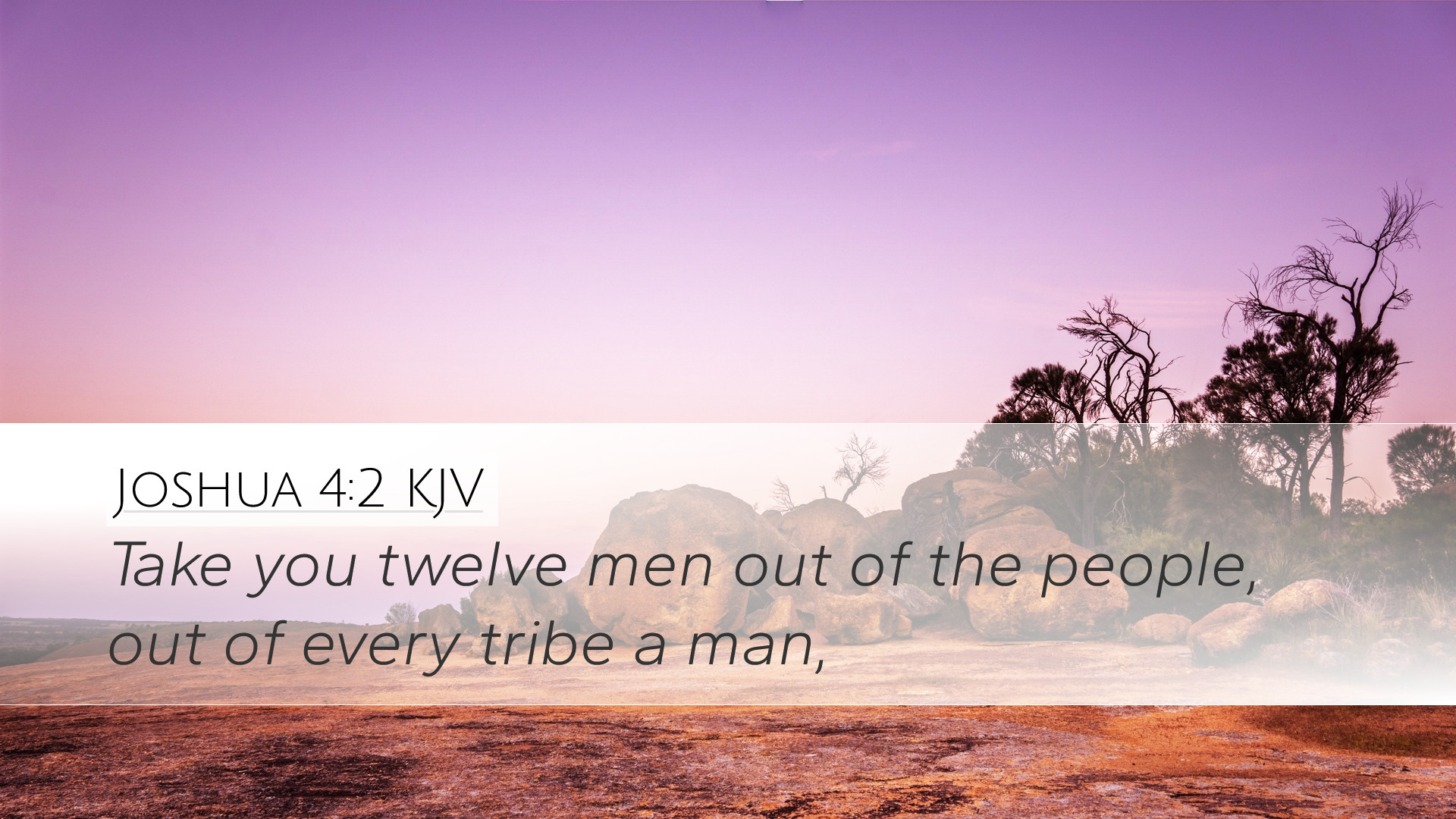Old Testament
Genesis Exodus Leviticus Numbers Deuteronomy Joshua Judges Ruth 1 Samuel 2 Samuel 1 Kings 2 Kings 1 Chronicles 2 Chronicles Ezra Nehemiah Esther Job Psalms Proverbs Ecclesiastes Song of Solomon Isaiah Jeremiah Lamentations Ezekiel Daniel Hosea Joel Amos Obadiah Jonah Micah Nahum Habakkuk Zephaniah Haggai Zechariah MalachiJoshua 4:2
Joshua 4:2 KJV
Take you twelve men out of the people, out of every tribe a man,
Joshua 4:2 Bible Commentary
Commentary on Joshua 4:2
Verse Context
Joshua 4:2 records a significant command from God to Joshua after the transcendental event of the crossing of the Jordan River. This chapter emphasizes God's faithfulness and the memorialization of His miraculous works among His people. The command to take twelve stones from the Jordan serves as a powerful symbol of remembrance and represents an act of obedience and faith.
Insights from Matthew Henry
Matthew Henry highlights the importance of giving thoughtful meaning to divine actions. He reflects on how these twelve stones act not only as a memorial of God’s miraculous provision but also as a tangible reminder for future generations. Henry considers the instructive nature of these stones, symbolizing the permanence of divine favor and historical continuity within the Israelite community.
He notes that these stones would provoke questions from children and future generations, prompting parents to recount the story of God's intervention and deliverance. Thus, the stones serve both as an anchor of faith for the current generation and a teaching tool for the next.
Insights from Albert Barnes
Albert Barnes elaborates on the act of selecting the stones, interpreting it as a deliberate action to instill memory and faith among God’s people. He expresses the importance of physical reminders in spiritual life, emphasizing that memorials function as instruments of encouragement and increase of faith.
Barnes points to the fact that the stones were taken from the very spot where the miraculous crossing occurred. This link to the miraculous event underscores the reality of God's presence and power. He reflects on how such physical elements can strengthen believers in their faith, serving to remind them of God’s sovereign acts throughout history.
Insights from Adam Clarke
Adam Clarke provides a rich historical perspective on the significance of the stones as markers of identity and divine intervention. He draws attention to the context in which the stones were taken, illustrating the transition from wilderness to the promise made by God—a transition from intent to fulfillment.
Clarke particularly focuses on the nature of God’s commands and the act of obedience displayed by Joshua and the Israelites. The importance of remembrance in the life of faith is reinforced—the memorial serves as a theological anchor, signifying not just history but the active presence of God in their lives.
Theological Significance
The gathering of the twelve stones symbolizes the twelve tribes of Israel, emphasizing unity and collective memory among God’s people. The stones from the riverbed depict a severing of ties from the past while also enabling the congregation to remember the full scope of God’s deliverance.
This act of memorialization can be related to the New Testament understanding of the Eucharist, where Jesus calls His followers to remember His sacrifice through the bread and wine. Likewise, the stones hold significant meaning as they encourage remembrance of both past salvation and present faithfulness.
Practical Application
For pastors and educators, the principle behind Joshua 4:2 serves as a vital guide on the necessity of instilling faith narratives within the community. This practice not only nurtures the current generation but also provides a foundation of belief for future followers. The construction of spiritual ‘memorials’—whether through stories, physical symbols, or communal practices—can serve to reinforce the faith and identity of congregations.
Moreover, this verse prompts an exploration of how churches can integrate the stories of God's faithfulness into their practices, ensuring they are not merely historical recollections but engaged narratives of promise and hope that foster a living faith among believers.
Conclusion
Joshua 4:2 commands us to remember and build memorials to God's faithfulness. Drawing on insights from respected commentators highlights how this act not only honors the past but also strengthens the future. By weaving these narratives into the fabric of community life, believers can cultivate a rich legacy of faith that transcends generations.


